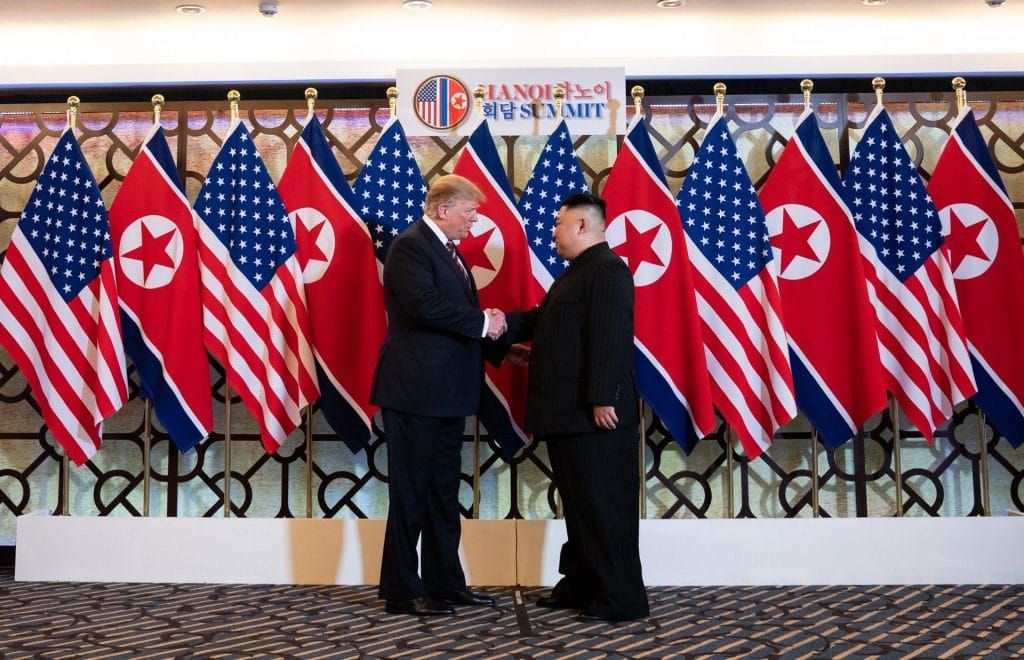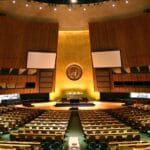A practical approach to North Korea for the next US president
By Joseph Yun, Frank Aum | October 2, 2020
 Donald Trump and Kim Jong Un shake hands at the Hanoi Summit in Vietnam, February 27, 2019. Photo credit: White House
Donald Trump and Kim Jong Un shake hands at the Hanoi Summit in Vietnam, February 27, 2019. Photo credit: White House
After three years of an erratic approach to North Korea, the Trump administration has made little progress in reducing the nuclear threat and enhancing peace and security on the Korean Peninsula. The Kim Jong Un regime not only maintains its stockpile of nuclear weapons and ballistic missiles, but these capabilities have grown both quantitatively and qualitatively. Indeed, after the failure of the Hanoi Summit in February 2019, Kim not only disavowed his self-imposed moratorium on nuclear and long-range missile testing, but committed his country to further strengthening its nuclear arsenal. Today, North Korea continues to enrich uranium, enhance its missile capabilities, and reverse the inter-Korean conciliatory measures taken in 2018. The next US president will have to address this grave situation.
Understandably, many critics have blamed the Trump administration’s “maximum pressure and engagement” strategy. They argue that the president’s sudden swing from pressuring North Korea to engaging directly with its leader squandered the leverage that Washington had painstakingly built. In other words, “maximum” pressure was never truly maximum.
But this criticism obscures the real problems with US policy toward North Korea. The biggest flaw is the belief that the United States can somehow bully North Korea into giving up its nuclear weapons. Any agreement with Pyongyang that is achieved through its reluctant submission rather than its motivated self-interest will be unsustainable. Also, it is unrealistic to demand that Pyongyang give up its greatest security guarantee up front without Washington taking simultaneous measures to improve bilateral relations. The worst rendition of this faulty approach was the maximalist “Libya” model that former National Security Advisor John Bolton championed prior to and during the failed Hanoi summit.
Washington should learn the right lessons from the failures of past approaches. It should discard maximalist policies based on quixotic dreams about near-term denuclearization. Instead, the next president should pursue a more pragmatic and aggressive diplomacy that prioritizes peace and stability in parallel with long-term denuclearization, engages in reciprocal and proportional measures, seeks realistic near-term results with tangible security payoffs, and gains support from regional partners. Failing to do so will lead to greater provocative behavior from the North, which will increase pressure on US allies South Korea and Japan and exacerbate their concerns about the reliability of US extended deterrence commitments.
Pressure is not enough. For the last several years, the United States’ working theory for denuclearizing North Korea has been to force the regime to choose between nuclear weapons and survival. Kim Jong Un needed to believe that possessing nuclear weapons was a greater threat to his regime’s existence and his country’s economic development than giving them up.
To sharpen Kim’s choices, the Obama administration enlisted the international community in a global pressure campaign. Countries were encouraged to cut diplomatic ties with Pyongyang and enforce economic sanctions. Washington also exerted military pressure by ramping up joint military exercises with South Korea; increasing deployments of bomber aircraft, a THAAD missile defense system, and other strategic assets to the Korean Peninsula; and helping Seoul acquire advanced US defense technology like Global Hawk unmanned aerial vehicles and F-35 stealth fighters. These moves had the additional purpose of warning China that the US–South Korea alliance force posture would only grow in ways adverse to Beijing if North Korea continued on its course.
In 2017, the Trump administration doubled down on the pressure campaign. President Trump declared that North Korean threats would be met with “fire and fury,” warned that the United States would “totally destroy” North Korea if attacked, and approved tougher UN sanctions after several North Korean provocations. Even after President Trump abruptly shifted to the “engagement” phase of his two-pronged strategy in mid-2018, his senior advisors, Bolton and Secretary of State Mike Pompeo, made it clear that there was no change in the US demand that complete denuclearization had to come first. Meanwhile, frustrated by years of North Korean intransigence, Congress passed legislation that strengthened, and even mandated, unilateral US sanctions against the Kim regime and its abettors.
Far from persuading North Korea to denuclearize, however, the pressure approach only seemed to intensify its pursuit of a credible nuclear deterrent. Between 2013 and 2017, the Kim Jong Un regime conducted four nuclear tests as well as 93 ballistic missile tests, nearly 50 percent more than his grandfather and father combined (63) over the previous 30 years. This surge in testing culminated in successful demonstrations of a 250-kiloton nuclear bomb and long-rage ballistic missiles capable of holding the entire continental United States at risk. A year later, a US intelligence assessment concluded that North Korea was unlikely to give up its nuclear weapons.
The pressure campaign did inflict heavy costs on North Korea. After the imposition of major UN and US sanctions in 2016 and 2017, North Korea’s revenues from exports to China, its top trading partner, plummeted by nearly 90 percent in 2018 and another 2.6 percent the following year. The COVID-19 pandemic led North Korea to close its borders, which caused exports to China to plunge an additional 67 percent in the first half of 2020. Pyongyang’s need for cash, especially foreign currency, appears so dire that the regime has banned the use of foreign currency for most domestic transactions and has begun to force wealthy individuals to purchase government bonds. Unsurprisingly, Kim made sanctions relief the top demand during the February 2019 Hanoi negotiations and continues to call for more belt-tightening in domestic statements.
Yet, there is a difference between imposing costs and changing behavior. North Korea scholar Van Jackson has persuasively argued that Pyongyang tends to respond to pressure with pressure rather than with accommodation. This defense mechanism stems from the belief that demonstrations of hostility and resolve are necessary to deter enemy aggression, and establishing a reputation of strength will ward off future threats by adversaries. In addition, studies have shown that economic sanctions are largely ineffective when seeking a major change in a regime’s behavior, and are more successful when the goals are modest and focused. This is because rogue states are often willing to endure high costs, including civilian suffering, to secure their national interests. As Vladimir Putin wryly noted, Kim would have his people “eat grass” before jeopardizing his regime’s safety.
The North Korean regime has been able to withstand the global pressure campaign for several reasons. First, it has developed sophisticated techniques to evade sanctions enforcement, including covert smuggling networks and illicit ship-to-ship transfers of prohibited goods. Second, many third countries do not have the capacity or will to enforce sanctions or adhere to UN reporting requirements. Third, the regime has generated billions of dollars through cybertheft from banks and cryptocurrency exchanges. Fourth, the adverse consequences of sanctions are mostly borne by the people, especially women, who often serve as caretakers and breadwinners, and children—one study attributed the death of 3,193 North Korean children in 2018 to sanctions-related delays and funding shortfalls impacting humanitarian assistance.
Most important, North Korea’s main benefactors, China and Russia, continue to act as a thermostat, ensuring that the heat never gets too high on their neighbor. Although they too would like to see North Korea denuclearize, they are more concerned with having a stable anti-US ally on their borders, which means preventing regime collapse. Thus, in 2019, Beijing pledged one million tons of nutritional assistance to North Korea (valued at over $300 million) to offset chronic food shortages. It also encouraged Chinese tourism to North Korea, which doesn’t violate UN sanctions but provides the Kim regime much needed cash.
Ultimately, a theory premised solely on pressure is futile if the targeted regime responds adversely to it, actively seeks to circumvent it, is willing to endure high costs and civilian suffering, and is aided by third countries that are unwilling or unable to apply it effectively.
What might work? A significant impediment for the United States is that it continues to narrowly limit its policy options while North Korean capabilities expand unabated. Washington’s window of discourse on North Korea policy largely consists of: Pressure the Kim regime through sanctions; don’t legitimize or reward it until preconditions are met; and don’t make any concessions until the North takes significant denuclearization measures first. To achieve any sustained results, these policy boundaries must be substantially widened to include more realistic and practical measures. We, along with our colleagues at the United States Institute of Peace, explored many of these issues in a recent report, “A Peace Regime for the Korean Peninsula.”
Prioritize peace in parallel with denuclearization. The first step is to recognize that the ultimate goal for all sides is peace and stability on the Korean Peninsula. Of course, each side regards peace differently—Washington views it as normalized relations granted after denuclearization, while Pyongyang sees it as the absence of “hostile” US actions prior to denuclearization. But getting North Korea to be a motivated and committed negotiating partner will mean acknowledging its view and harmonizing the two approaches. Pyongyang has consistently called for a new paradigm that fundamentally transforms the relationship between the two countries from enmity to peace. In the June 2018 Singapore Statement, Kim insisted that his commitment to “work toward complete denuclearization” must be matched by a US commitment to establish “new US–DPRK relations” and build “a lasting and stable peace regime on the Korean Peninsula.” Despite the current stalemate in negotiations, Pyongyang tellingly has not renounced the Singapore Statement, which it has done with other previous agreements. The realistic and logical approach is to pursue both peace and denuclearization in parallel. Most of the Six Party partners—South Korea, North Korea, China, and Russia—would endorse this framework quickly.
Ensure reciprocity and proportionality. Negotiating peace and denuclearization in tandem requires a reciprocal, proportional, and simultaneous exchange of concessions that addresses both sides’ interests. The United States has always been comfortable listing all of the denuclearization and human rights measures it wants from the North. However, a balanced approach means acknowledging North Korea’s sovereignty, declaring a formal end to the Korean War, and establishing a pathway to signing a peace treaty and normalizing relations. Early confidence-building measures, such as ending the ban on travel to and from North Korea, establishing liaison offices in each other’s capitals, offering humanitarian assistance, and increasing people-to-people exchanges will help reduce tensions and provide momentum in peace and denuclearization negotiations. Washington will also have to seriously consider when and how to address Pyongyang’s more difficult demands, including relief from economic sanctions, the disposition of joint US–South Korea military exercises, and the deployment of US nuclear and strategic assets to the Korean Peninsula. Conventional arms reduction negotiations would be a good starting point.
Emphasize realistic, short-term security payoffs while playing the long game on denuclearization. For 15 years, Washington has chased the white whale of complete, verifiable, and irreversible denuclearization at the expense of achieving near-term, material reductions in the nuclear threat. But doing so has made the perfect the enemy of the good. North Korea will not easily give up its “treasured sword,” which represents the only noteworthy success in its history. Today, more and more experts recognize that complete denuclearization in the short- and medium-term is a pipe dream, but an interim deal that freezes North Korea’s nuclear and missile activities can largely be achieved and verified and would have an immediate security payoff. Timely, tangible progress in addressing each side’s security concerns can then help provide the foundation, trust, and momentum for additional gains down the road.
Denuclearization should still remain a goal. Credible or not, Kim pledged to “work toward complete denuclearization of the Korean Peninsula” in Singapore, and told reporters in Hanoi that “if I’m not willing to [denuclearize,] I wouldn’t be here right now.” Abandoning the goal of North Korea’s denuclearization could sound the death knell for the nonproliferation regime and make it easier for countries like South Korea and Japan to pursue their own nuclear weapons, triggering profound instability in the region and beyond. Washington must pursue denuclearization, but accept the reality that it will entail years of negotiations, numerous setbacks, and sustained confidence-building measures. The key challenge is to have the process persist through changes in administration and periodic breakdowns.
Enhance buy-in from regional partners. A sincere effort at peace and denuclearization will require the participation of China and South Korea, the other main belligerents of the Korean War. Once US–North Korea negotiations achieve even a small opening, the process should quickly be opened to these two countries. Admittedly, broadening the talks would introduce complications and challenges, especially since US strategic goals in the region do not align with China’s. But Washington will not be able to create a sustainable framework for advancing peace and security on the Korean Peninsula without partnering with Beijing and Seoul. At an appropriate time, Tokyo and Moscow should be brought in as well.
North Korea will be watching the US presidential election very closely. Whether the winner is Donald Trump or Joe Biden, Pyongyang will likely test him immediately by manufacturing a crisis to create leverage and kickstart diplomacy on its preferred terms. Instead, the next US president should quickly seize the narrative by signaling that Washington is prepared to discuss both peace and denuclearization with Pyongyang and open up the talks to China and South Korea. Doing so will help establish a practical path to building a new framework for peace and security on the Korean Peninsula.
The views expressed in this article are those of the authors only and do not necessarily reflect the position of any agency with which they are affiliated.
Together, we make the world safer.
The Bulletin elevates expert voices above the noise. But as an independent nonprofit organization, our operations depend on the support of readers like you. Help us continue to deliver quality journalism that holds leaders accountable. Your support of our work at any level is important. In return, we promise our coverage will be understandable, influential, vigilant, solution-oriented, and fair-minded. Together we can make a difference.
Keywords: Kim Jong-un, Korean Peninsula, North Korea, denuclearization
Topics: Nuclear Weapons

















Well, what do you know! A proposal from some Washington officials that actually addresses the real issues, and states what has been obvious to outside observers for half a century: the foundation for all serious efforts is a peace treaty.